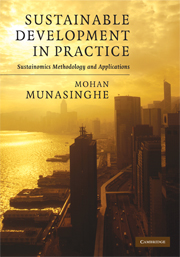Book contents
- Frontmatter
- Contents
- Foreword by James Gustave Speth
- Preface
- Part I Framework and fundamentals
- Part II Global and transnational applications
- Part III National and macroeconomic applications
- Part IV Sub-national sectoral and system applications
- 10 Energy-sector applications
- 11 Transport-sector applications
- 12 Water-resource applications
- 13 Ecological and agricultural system applications
- 14 Resource-pricing-policy applications
- Part V Project and local applications
- References
- Index
13 - Ecological and agricultural system applications
Published online by Cambridge University Press: 05 August 2012
- Frontmatter
- Contents
- Foreword by James Gustave Speth
- Preface
- Part I Framework and fundamentals
- Part II Global and transnational applications
- Part III National and macroeconomic applications
- Part IV Sub-national sectoral and system applications
- 10 Energy-sector applications
- 11 Transport-sector applications
- 12 Water-resource applications
- 13 Ecological and agricultural system applications
- 14 Resource-pricing-policy applications
- Part V Project and local applications
- References
- Index
Summary
This chapter describes sustainomics applications to two main types of ecological systems – forests (natural ecosystems) and agriculture (managed ecosystems). Section 13.1 describes the underlying reasons for deforestation. It analyses the management of megadiverse natural ecosystems in rainforests, and then identifies generic policies that make forest use more sustainable. In Section 13.2, a case study of Madagascar seeks to understand better the specific impact of parks-management policies on tropical forests. The environmental, social and economic consequences of human actions are assessed, with specific focus on the economic valuation of environmental impacts. Various methods (e.g. opportunity cost, contingent valuation, travel cost) are used to value economically damage to forests and watersheds, timber and non-timber forest products, impacts on local inhabitants and biodiversity and ecotourism benefits. Relevant policy implications are drawn. Sections 13.3 and 13.4 present a second case involving the vulnerability of managed ecosystems (agriculture) to climate change in Sri Lanka. A Ricardian agricultural production model estimates the past effects of natural variations in both temperature and precipitation. Then, several scenarios of future climate change are imposed to assess future agricultural production. The harmful impacts of rising temperatures dominate the beneficial effects of increased rainfall. Policy conclusions are drawn for sustainable agricultural policy in Sri Lanka.
Sustainable management of tropical forests
Deforestation issues
Tropical forests consist of dry and moist forests, each accounting for roughly half the total of about 3.1 billion hectares found worldwide. Tropical moist forest are further divided into rain forests and deciduous forests.
- Type
- Chapter
- Information
- Sustainable Development in PracticeSustainomics Methodology and Applications, pp. 424 - 459Publisher: Cambridge University PressPrint publication year: 2009



